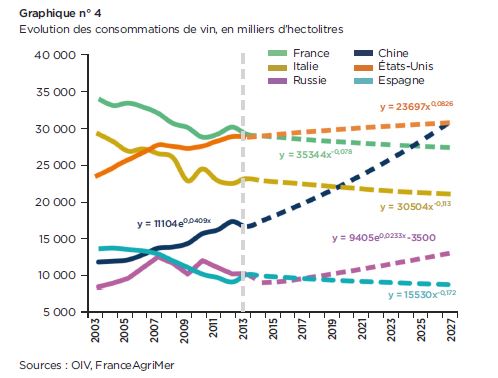According to calculations by Coface (a French export credit insurer), China will be the top market for wine in the world in 2027, ahead of the United States, France, Italy and Germany. World wine consumption should rise by approximately 10% in the same time-frame, but will double in China (to 30 million hectolitres).
China currently ranks fifth in the world for wine consumption with 16 million hectolitres drunk in 2014, but a dozen years from now, it will be in first place (it is already the leading consumer of red wine). Wine consumption in China has doubled between 2005 and 2010.
Coface is actually predicting that the democratisation of wine will continue and accelerate in China, with the trend being fostered by the growth of the middle class, which could enlarge threefold by 2022. By contrast, French and European consumption will remain flat.
China’s wine consumption could therefore exceed that of France by 2025 and the United States by 2027. In fact, consumption there could rise from 1.3 litres per inhabitant per year to 2 litres, which is sufficient to make it the top world wine market due to its population of 1.3 billion. During this same period, France, which is currently the world’s top wine consumer per inhabitant, will reach 47.7 litres. Chinese consumption therefore still has a very long way to go, as was emphasised by Paul Chollet, Head of Sector Studies and Insolvency at Coface.
Urbanisation, which is still underway in developing countries such as China (where it experienced a boom from 1985 to 2014, with +140 % growth) plays a significant role in the increase in wine consumption. This urbanisation is set to continue since in China just 50 % of inhabitants live in urban areas (compared to 77.5 % in France, for example). The rise in GDP is also clearly a major factor in this increase in wine consumption, and it is precisely in China and Asia that it is at its highest (+5 % between 2020 and 2025). The main stakeholders in the democratisation of wine in China are cafés, hotels and restaurants, whereas local stores stock mostly Chinese wines. Hong Kong also plays a key role due to the abolition of import duty in 2008.
There was, however, a real dip in Chinese demand between 2011 and 2014, with exportation reduced by 35 % in volume and 43 % in value, after several years of rapid rises, but this would appear to be due to a standardisation of the Chinese market. “People were buying wine for the bottle and the label, just like a precious object. The competitive area is now more in the mid and budget price range,” explained Guillaume Baqué, an economist at Coface.
Now, the issue obviously lies in identifying who will benefit from the rise in Chinese consumption. Up to this point, French wines, and Bordeaux wines in particular, have held the top spot. However, competition with New World wines will become stiffer. This competition is already relatively significant in China, with greater penetration by Australian, Chilean and US wines in recent years, and it will continue to increase, in particular due to anti-corruption legislation. In actual fact, “for 40 % of Chinese consumers aged between 18 and 29, price is the top consideration when buying,” according to Guillaume Rippe-Lascout. 2018 will be a critical turning point, with the abolition of import duty for Australia, New Zealand and Chile facilitating market penetration for these stakeholders and making competition in mid-range products even stiffer. However, it should be remembered for the time being that most Chinese wine consumption involves locally produced wine (80 % in 2014) and that as of last year, China has the second largest number of vineyards in the world after Spain and ahead of France. Wine quality is improving significantly, notably due to advice from French oenologists.




